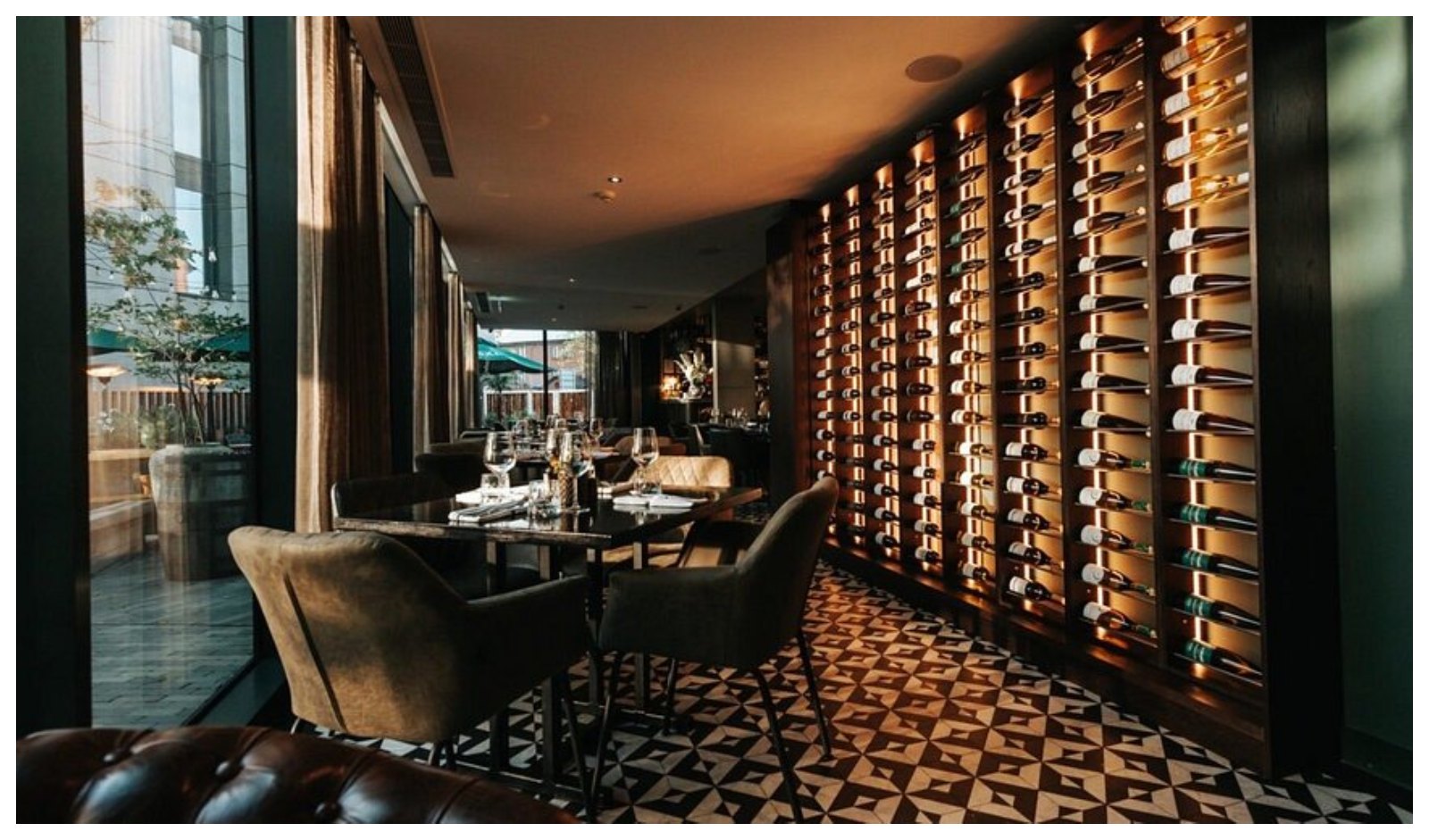
BY CHEF RAJI
A fine dining experience is not just limited to food, but is rather a culmination of taste, ambience and service, which makes it a memorable experience for the guests. The picture of such an experience would entail a cosy aura, perhaps a few beautifully arranged bouquets of flowers, delicious and fulfilling food and convivial company to add the finishing touch. All these ingredients come together to create a satisfaction that surpasses just the gastronomic pleasure.
So, if you intend to provide your guests with such an experience, then while keeping their entertainment in mind, start by mulling over a menu for them, including both food and wine that will delight their senses as well as fit the occasion. In the end, at the heart of the success of this is delicious food.
Here are a few pointers which can help you to go one step ahead in making a fine dining experience more special and entertaining than a standard party
1. Planning the Menu – Having a menu that caters to all your guests is essential for the high success rate of the event. Depending upon the number of guests invited, do keep in mind their preferences, common allergies and other details. The food need not necessarily be elaborate, but it should reflect the style of the host and the occasion.
2. Table Set-up – The way the table is set gives the guests the initial impression of how the experience is going to be. It sets precedence for the rest of the evening and subconsciously the guests start to relate the entire experience in that context. So if you want to set a good impression initially, then focus on proper table arrangement that goes along with the theme and mood of the party.
3. Divide your Work –Many times people tend to take over more burden than they can handle. This leads to distractions which divides the focus into multiple tasks. Such a thing also impacts the quality of the work. To reduce the compromising on the overall quality of the project, don't hesitate to take help so that you can keep an eagle’s eye on the bigger picture.
4. Setting Up the Bar – A bar is a thing of joy only up till it is handled by a professional bartender if the party is of more than 10 people. Otherwise if left to the devices of guests or an ineffective bartender, there would be anarchy. To keep the mood set, be sure to set an easy circulation area, so that the bartender can focus onmultiple guests at a time. Good alcohol equals to a good party.
5. Dressing the Table – Nothing beats the aesthetic appeal of the background setting of a party scene. This backdrop becomes enhanced when flowers, fruits, plants, herbs and other decorative serving pieces are added to the table to bring it to life. Not to mention, they provide a perfect backdrop for beautiful Instagram pictures.
6. Serve-ware – Once you have your menu sorted and finalised, then you can choose the appropriate cutlery, as well as its quantity for the ease of the guests. These pointers go hand in hand, paired by their mutual dependency of complimenting each other’s task and also to do justice to the planned menu.
7. Selection of Wines –Some more wine monsieur? While eating out at a place that offers fine dining experience, adding rich wine choices helps to relax the atmosphere which adds the element of uniqueness. But how to choose which wine works best for your party. Usually, if it's a casual dinner, then expand your choices and accommodate in different wines with alcohol for a genuine cocktail experience. It's much easier if you’re entertaining a small number of people.
8. Sweet Endings – Like the final sound of the scrumptious symphony, let your guests leave the place with the sinfully delicious taste of dessert lingering in their palate. A delectable, luscious, refreshing, and irresistible dessert is for many of us the most exciting part of the menu.
So let's "Gather & Gobble"!

As India’s hospitality sector enters its next growth cycle, hotel kitchens are undergoing a fundamental reset where creativity is balanced with operational clarity, while innovation is grounded on purpose and dining experiences carry both flavour and responsibility.
As per reports, the hotel industry is projected to grow by 4.75% to 9.4% in next few years, targeting both metros as well as smaller cities that has attracted tourist attentions.
Sustainability Takes the Lead
Sustainability has moved from being a trend to becoming a mandatory operational standard. Supreet Ghai, Culinary Director for Ibis Hotels said, “By the end of 2025, all 25 Ibis and Ibis Styles hotels across India will shift entirely to the cage-free eggs, positioning the brand among the first national hospitality chains to execute a 100% transition.”
He stressed that responsibility extends far beyond ingredients and his teams are now implementing carbon footprint on menus to help diners access the environmental cost of what they order, transforming the act of choosing a dish into an act of awareness.
“Sustainability is not just an ingredient list. Its behavior, a lifestyle, a mindset every chef must embrace,” commented Ghai.
Story Builds Connect
Food brings a story; it’s not just for the photos as the era of food designed only for Instagram is fading and giving a way out to menus to be built on emotion, narrative and cultural relevance.
Rahul Shrivastava, Executive Chef, Hyatt Centric Juhu noted that today’s diners want dishes with meaning, foods that carry memory, technique and soul. Whether it is meticulously prepared in three-days i.e. Nai Karampatti Gola Urundai or the revival of Litti Chokha, guests are increasingly drawn to plates that speak to heritage and lived experiences.
“Guests come back for taste, not just the photo. The story behind the dish is what connects to the heart. This desire for meaningful engagement is fueling the rise of chef’s tables, curated pop-ups, regional showcases, and even omakase-style experiences extended to non-Japanese cuisines,” he said.
Hyper-Local and Forgotten Recipes Take the Spotlight
Regionality is no longer a niche idea; it is the backbone of India’s culinary future. Hotels are moving beyond broad categories such as Bengali or Chettinad cuisine and venturing into hyper-specific traditions rooted in villages, traveler’s path and local communities. Forgotten recipes, ancient cooking techniques, and regional snacks are finding space on hotel menus.
Ghai’s Railway Chicken Curry which reimagines the Kolkata’s colonial-era culinary culture reflects a growing desire among guests to rediscover authenticity wrapped in nostalgia. “We connect the dish with the story to the customers and that helps in getting repeat customers which help in the long run.”
Creativity vs Feasibility
With 25 hotels under his leadership, Ghai acknowledged that it’s very important to understand the customers. Menu should be planned as per the clientele and creativity must be balanced with feasibility.
To meet these diverse expectations, Ibis maintains a strategic structure: 75–80% of the menu remains standardized across properties, while the remaining portion is dedicated to regional customization and chef-driven innovation.
Shrivastava added that feasibility is also dictated by manpower.
“As skill shortages rise, kitchens must design menus that match the capacities and strengths of their teams. Creativity goes hand-in-hand with feasibility. If your team does not know much about the kitchen, then it’s a challenge.”
AI, Automation & the New Kitchen Ecosystem
Automation has shifted from being an enhancement to being a survival mechanism. AI-driven platforms are already enabling hotels to track waste, maintain consistency across multiple outlets, manage inventory with precision and reduce dependency on manual labour.
Sharing his views, Ghai said, “The hotel kitchens being built today must be designed with the realities of labour shortages over the next decade firmly in mind. In 2025-26, technology will shape the backbone of culinary operations as much as talent and technique.”
India’s hospitality landscape is evolving rapidly, and its chefs are not just adapting to change, they are shaping the future with intention, innovation and a renewed sense of purpose.

Culinary excellence has evolved over the years. It is highly shaped by global influences, technology and changing consumer expectations. Trends like sustainability, hyper-personalization, cultural storytelling, fine dining, wellness focus innovation and presentation are shaping up the market scenario. The global culinary market is projected to grow at a steady CAGR of 10–11%, reaching over $4 trillion by 2030.
Culinary skills are really important to expand their horizons as it gives a deeper understanding of food, culture and art. Chefs should have all the knowledge to enhance the culinary experience with guest satisfaction. While Culinary arts focus on mastering techniques, understanding ingredients and food science, and building skills in menu planning, costing, and food safety.
Comprehensive Training is Essential: Striking a balance between authenticity and innovation is a nuanced endeavor—stray too far, and the soul of the dish is lost; cling too tightly, and evolution is stifled. Comprehensive training in both classical and contemporary techniques ensures that consistency and creativity thrive in harmony.
Chef Ranjeet Yadav Executive Chef, Courtyard by Marriott Ranchi pointed that consistency and innovation with intent are really important. “Consistency plays a major role. Every plate that leaves the kitchen must reflect our standards. This comes from training the team rigorously, standardizing processes, and ensuring quality control across every step — from sourcing to plating.
Uncompromising Dedication to Premium Ingredients: Sourcing traditional ingredients sustainably, especially at scale, presents ongoing challenges. Chef Avishek Bagchi, Executive Sous Chef, JW Marriott Kolkata said, “At its core, sourcing the highest quality, freshest ingredients through ‘sustainable sourcing’ are non-negotiable—it forms the foundation of exceptional cuisine, amplifying both flavor and nutritional value.”
Commenting on the same, Chef Mohd. Merajuddin, Executive Chef, ITC Grand Goa Resort & Spa said, “At ITC Grand Goa, our foremost strategy is rooted in local sourcing and seasonal intelligence. We emphasize using indigenous Goan ingredients, from toddy vinegar to kokum, blending them seamlessly into global and regional cuisines. The second is team craftsmanship—investing in rigorous training, constant innovation, and collaborative creativity.”
Equally essential is inspirational & heirloom innovation—which fuels creativity without forsaking authenticity. “It involves continuously evolving techniques, integrating contemporary methods, and reimagining time-honored recipes to suit modern palates,” added Bagchi. Navigating these demands requires cultivating strong relationships with ethical suppliers and nurturing cultural sensitivity across teams.
Consistency & Innovation is the Key: One has to keep on innovating to stay ahead of the competitors. It helps in curating new dishes and innovations through unique presentations. Consistency is the key to everything.
“Innovation with intent. We don’t innovate for novelty; we do it to elevate the guest experience. Whether it’s curating local-inspired menus, embracing wellness trends, or enhancing presentation, the goal is to surprise and delight while staying true to the Courtyard brand ethos,” added Yadav.
Managing Rising Cost: The biggest challenge in a kitchen is managing rising ingredient costs, maintaining consistency with a large team, and adapting quickly to changing guest expectations.
Pointing his views on this, Chef Yadav added, “We overcome these with a proactive approach — regular cost reviews, seasonal and local sourcing to optimize pricing, and team empowerment through continuous training. We also take feedback seriously — not just from guests but internally — so we can fine-tune our operations in real time.”
Talent Retention: The solution lies in systems and soul: adopting smart kitchen tech for precision and planning while keeping the human touch intact. Chef Merajuddin shared that another challenge is talent retention. “We’re addressing it by creating an environment that’s about purpose, not just pressure—empowering our young chefs to grow with pride and accountability.”

The restaurant space across the world is going through a transformation. The changing palette of customers, the awareness around healthy food habits, the coming in of technology and a lot many factors are fast changing the restaurant scene in India and also abroad. COVID- 19 too had a transforming effect on the restaurant ecosystem and has taught the industry a lot many new things while helping it unlearn some. In this ever-changing restaurant industry, here are 5 culinary practices that are fast changing the restaurant scene.
Integration of Technology
The restaurant industry has seen unprecedented technological enhancements that have completely changed the way people are dining out. From digital menus, mobile apps to order food and reserve a table, QR code to scan and pay to a backend Artificial Intelligence driven analytics, the restaurant experience is completely digitalized today. While for the consumer, the restaurant experience can be completely contactless, the back-end technology also supports automated inventory management and analysing consumer preferences to serve the customers better. With technology, the experience has become more personalised, curated and seamless.
Focus on Health and Wellness
Consumers today are becoming more health conscious, leading to a change in eating habits. This has led the restaurants to respond by offering more nutritious menus. The restaurant menu has gone through a complete transformation in recent times with the inclusion of many healthier options beyond soups and salads, often with a calories’ breakup and other detailed specifications. Restaurants today follow the protocol of transparency providing all details about ingredients used along with their nutritional details. There have been new additions in the menu too such as vegan, gluten-free and a lot more options.
Emphasis on Sustainability
Restaurant Sustainability is the new normal. A lot of emphasis is being given to sustainability, right from sourcing the right ingredients, to reducing food waste to even serving in eco-friendly tableware. The goal today is to reduce the impact on the planet and restaurants are making a positive shift toward sustainability. More and more restaurants are making an effort to narrow the supply chain by ordering locally grown produce. Recyclable paper napkins and linens are being used more often besides focusing on biodegradable packaging. Reducing food waste is another important factor that restaurants take into account very seriously and also go a step ahead in sensitising the customer and staff alike.
Cloud kitchens are here to stay
The entry of cloud kitchens and their success is a big achievement for the restaurant industry. It has helped many small businesses to grow and expand. Cloud kitchens are a great way to cut overhead costs and hence build a flourishing business. With the trend of ordering food seeing an unprecedented rise during and after lockdown, cloud kitchens have come up as a parallel entity besides sit-down restaurants. And with the demand for outside food increasing among the consumers, there will always be a demand for food from cloud/ghost kitchens. Cloud kitchens also serve a widespread menu including healthy dishes and international cuisines besides the regular Indian fare.
Celebration of Cultural Diversity
Restaurants today have the most widespread menu. With consumers today becoming more and more experimental in their food choices, restaurants today cover a wide range of global cuisine. While there has been a rise in multi-cuisine restaurants, there has also been a huge growth of restaurants serving international cuisines. There are many restaurants today that serve authentic Pan-Asian, Japanese, Korean and other cuisines. Restaurants today celebrate the diversity in world cuisine besides holding on to the all-time traditional Indian fare.

As the world unites to honour World Environment Day, immerse yourself in a culinary revolution that promises not just to tantalize your taste buds, but also to nurture our planet. The Godrej Food Trends Report 2024 curated by Godrej Vikhroli Cucina was recently unveiled.
Crafted with insights from over 190 visionary thought leaders—including celebrity chefs, influential bloggers, and dedicated nutritionists—the report highlights the most transformative trends in sustainable food practices. These trends are poised to revolutionize the way we eat and think about food, paving the way for a healthier, more sustainable future for generations to come.
Key Trends for World Environment Day 2024:
Supporting Local Farmers & Producers: Nearly 90% of the experts predict a surge in consumer interest in supporting local farmers and producers. This trend emphasizes the need for sustainable and ethically sourced food. As consumers become more aware of the environmental impact of their choices, they seek ways to contribute positively to their communities.
Adopting a Climatarian Diet: In 2024, approximately 75% of experts believe that people will increasingly adopt a climatarian diet. This dietary shift focuses on foods with a lower carbon footprint, promoting environmental sustainability. By making conscious choices, individuals can reduce their impact on the planet while enjoying delicious and nutritious meals.
Sustainable Packaging: The panel expects a strong demand for sustainable, eco-friendly packaging. With 71% of experts emphasizing this trend, it’s clear that consumers are becoming more environmentally conscious. Brands and manufacturers are responding by exploring innovative packaging solutions that minimize waste and promote a circular economy.
As we embrace these trends, let us commit to choices that benefit both our palate and our planet. Support local farmers, adopt climate-friendly diets, and champion sustainable packaging to build a healthier, more sustainable world.

In the dynamic landscape of the culinary world, where flavors tantalize taste buds and ambiance sets the mood, restaurants must navigate the realm of marketing to thrive. In 2024, restaurants must harness a diverse array of strategies to captivate audiences and secure their place in the hearts and minds of diners. From digital prowes to community engagement, here are eight groundbreaking restaurant marketing strategies to elevate your establishment's presence in the dining scene.
1. Craft Compelling Email Campaigns
In the digital age, the power of email marketing remains unparalleled. With automation features, restaurants can forge direct connections with customers, fostering positive engagement and influencing dining decisions. By striking the delicate balance between frequency and relevance, restaurants can leverage email campaigns to cultivate a loyal customer base.
2. Unlock the Potential of SMS Marketing
Harnessing the immediacy of SMS marketing, restaurants can capture attention with enticing messages. While the click-through rate may be modest, the high open rate presents an invaluable opportunity. From exclusive discounts to event tie-ins, SMS marketing offers a direct line to diners, inviting them to indulge in culinary delights.
3. Seize Control of Online Listings
In an era dominated by digital discovery, the importance of curated online listings cannot be overstated. By claiming and updating listings on platforms like Facebook, Google, Yelp, and TripAdvisor, restaurants assert their online presence and attract new customers. Empowered with control over their digital narrative, restaurants can strategically position themselves for visibility and acclaim.
4. Leverage Influencer Partnerships
Influencers wield considerable sway in shaping consumer preferences, making them valuable allies in the restaurant marketing landscape. By collaborating with local influencers and leveraging their expansive social media reach, restaurants can amplify their brand presence and cultivate a devoted following. From renowned foodies to hometown heroes, influencers offer a powerful platform for showcasing culinary excellence.
5. Cultivate Community Connections
Beyond the confines of the dining room, restaurants have the opportunity to make a meaningful impact in their local communities. Whether through charitable partnerships or philanthropic initiatives, restaurants can embody values of compassion.
6. Embrace the Return of Physical Menus
While digital menus have their place, the menu beckons diners with its tangible appeal. By offering physical menus alongside digital alternatives, restaurants cater to diverse preferences and enhance the dining experience. With clear, visually appealing menus, restaurants set the stage for culinary exploration and elevate the art of dining.
7. Spotlight Stellar Staff
Behind every exceptional dining experience are the dedicated individuals who bring it to life. By showcasing the personalities and talents of their staff, restaurants humanize their brand and foster a sense of familiarity. From kitchen maestros to charismatic servers, highlighting the individuals behind the scenes adds depth to the dining narrative and strengthens customer connections.
8. Cultivate Organic Advocacy
In the realm of restaurant marketing, there is no substitute for genuine word-of-mouth endorsement. By delivering exceptional culinary experiences and service, restaurants cultivate a loyal base of advocates who eagerly spread the word. From tastings at local establishments to collaborations with business organizations, restaurants can organically expand their reach and solidify their status as culinary destinations.
In the dynamic landscape of restaurant marketing, innovation is the key to success. By embracing these strategies, restaurants can navigate the complexities of the digital age while forging authentic connections with patrons, ensuring a seat at the table of culinary distinction in 2024 and beyond.

Aashita Relan goes candid in saying females have remarkably made progress in culinary business. In an interaction, she talks about the important steps to get ones business up and running and about issues of high rental and service tax levied on AC restaurants.
The culinary world is notoriously male dominated. How have you found your way as a female restaurateur?
There are many females who have made their mark in the food and beverage segment. I don’t agree that culinary world is male dominated. If we talk about Ritu Dalmia, we can see that she owns one of the biggest food brands in India.
What strategies did you follow to make your business start and run?
The most important task was to pick the ‘correct staff’ and among staffs the most taxing was to choose the correct chef because chefs are the king of a restaurant. Even the selection of good staff holds importance as they are the ones who are responsible to execute plans and try new things at your restaurant.
Choosing the correct menu is also very important because you should have a good mixture of dishes.
What was the biggest challenge you faced while opening the restaurant?
I was very young at the time I launched the restaurant. The biggest challenge that I faced was to get people on work because I was new to the industry. I was interviewing people who were 50-60 years old and were well established, so I was a bit apprehensive about getting them on the restaurant.
What is your secret to keep customer coming in? What have been your most successful promotions and from where did they come from?
A customer keeps coming to a restaurant because of the quality of food and service. The one thing that I am very particular about is the ingredients we use. It should be the freshest and of high quality, and this is the reason that whenever customers come back to our restaurant they say that the quality of food has always been maintained. On all seven days, the quality of the food we serve is the same and it makes an important role in getting people coming back to restaurant.
My most successful promotion till date was the ‘unlimited dim sum lunch’ festival where a customer can come on any seven day during lunch time and pick from 80 different types of dim sum at any quantity. The idea clicked my mind when I visited a restaurant in London offering the same promotion.
What is the best way for fresh graduates to find a job in the restaurant management?
To join the restaurant line, hard work, dedication, physical fitness and the passion for food along with fluency in English helps.
What do you think when you hear someone saying: “Owning a restaurant looks like fun”?
I feel the person who thinks that running a restaurant is like fun is the last person who is unsuccessful because it is the hardest industry to be in. You are the one who are going to handle the most difficult customer, and it is a segment where you have to work 24x7.
How do you feel about the high rental and high service tax levied on AC restaurants?
I think the restaurant in Delhi has very high rental and unacceptable service tax reason being it is very difficult to pay the taxes levied on restaurants. I run my business from a rented place but when I would open my second restaurant I would ensure that it is not a rented one because it is much more practical to run a restaurant at your own place rather than at a high rental place. I think the high taxation levied on restaurant is really unfair and the government should really look into it and revise the law. And I feel by doing something like this the government is slowing down the hospitality industry.
What tips would you like to give to run a successful restaurant?
Dedication, be careful 24x7, look after everything yourself. I would say is never ever compromise on quality, always use the freshest and most authentic ingredients of the best brands because it is only the food for which people are coming to a restaurant. The customer is always right so always listen to your customer.
What new can we see in Royal China in near future?
I’m setting up a new dim sum menu which will have 12 different varieties of what we have till date.
Copyright © 2009 - 2025 Restaurant India.















